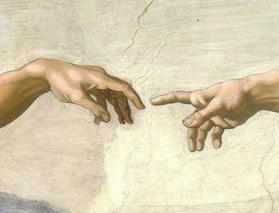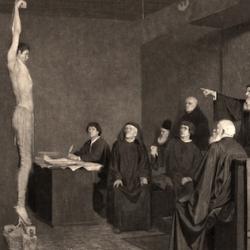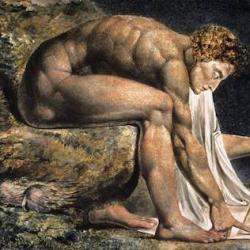Imagine, Peter Harrison suggests at the beginning of The Territories of Science and Religion, a historian who claimed to have discovered evidence of a war between Israel and Egypt that took place in 1600 AD. We’d be justifiably skeptical, and the evidence could be refuted with a swipe of the hand: The states of Israel and Egypt didn’t exist in 1600.
Harrison argues that claims about an early modern war between religion and science should be greeted with the same skepticism. They couldn’t have been at war in the early modern period because neither science nor religion as we conceive them existed. At that time, religion wasn’t what we think of as religion, and science wasn’t what we think of as science.
Harrison has traveled some of this path before. In his 2002 ‘Religion’ and the Religions in the English Enlightenment, he traced the development of modern concepts of “religion” and examined how they played out in the new science of comparative religion. Ficino provided a nearly archetypal statement of the new concept: “In De Christiana Religione (1474), he proposed that religio, despite appearances, was at all times and in all places the same thing – namely, a universal property of humanity, a distinguishing characteristic, and the one thing which made humanity human: ‘The word of god is as natural to men, as is neighing to horses or barking to dogs.’ We should not be deceived by the appearances of multiformity, urged Ficino: ‘All human opinions, all responses, all customs change – except religion.’” Religion is the one unchanging anchor in a world of flux.
Harrison’s new book, a revision of his 2011 Gifford Lectures and the capstone to a series of books about religion and science, combines his genealogical studies of “religion” with a similar genealogy of modern concepts of “science.” He doesn’t deny, of course, that human beings have investigated the natural world and worshiped since ancient times, and he doesn’t deny that human beings knew the difference between the two. But pre-modern investigations of natural phenomena have “only a remote resemblance” to what we conceive of as science, and only recently have beliefs and practices been bundled together under the generic category of “religion” (3). The territories of science and religion, like those of Israel and Egypt, are of recent origin.
Harrison pushes the analogy between political and intellectual “territories.” In neither case are the borders simply given. We create political borders, and they are often changed. We likewise map our intellectual pursuits, and those lines shift and change too. In both cases, the maps correspond in some way with the world out there: Borders follow rivers and mountain ranges, and there’s an obvious difference between studying a text and studying a tardigrade. But that’s not the whole story for either politics or the work of research. Interests and ambitions and unanticipated events always play a part, sometimes the starring role. Political borders don’t always follow the features of the landscape; our political maps bear the scars of struggle and war, and so do our intellectual mappings.
Political and intellectual territories shift for similar reasons: “Just as the borders of nation-states are often more a consequence of imperial ambitions, political expedience, and historical contingencies than of a conscious attending to more ‘natural’ fault lines of geography, culture, and ethnicity – think in this context of the borders of the modern state of Israel – so the compartmentalization of modern Western culture that gave rise to these distinct notions ‘science’ and ‘religion’ resulted not from a rational or dispassionate consideration of how to divide cultural life along natural fracture lines, but to a significant degree has been to do with political power—broadly conceived—and the accidents of history” (3-4).
Once of the primary changes Harrison examines is from internal to external. Prior to the seventeenth century, both “religio” and “scientia” were virtues, not courses of study or institutional structures. According to Harrison, “for Aquinas religion (religio) is a virtue – not, incidentally, one of the preeminent theological virtues, but nonetheless an important moral virtue related to justice. He explains that in its primary sense religio refers to interior acts of devotion and prayer, and that this interior dimension is more important than any outward expressions of this virtue. Aquinas acknowledges that a range of outward behaviors are associated with religio – vows, tithes, offerings, and so on—but he regards these as secondary” (7).
Scientia was also a virtue or habit, but an intellectual one. In Harrison’s summary, Thomas linked “science with the derivation of truths from those first principles, and wisdom with the grasp of the highest causes, including the first cause, God. To make progress in science, then, was not to add to a body of systematic knowledge about the world, but was to become more adept at drawing ‘scientific’ conclusions from general premises. ‘Science’ thus understood was a mental habit that was gradually acquired through the rehearsal of logical demonstrations. In Thomas’s words: ‘science can increase in itself by addition; thus when anyone learns several conclusions of geometry, the same specific habit of science increases in that man’” (11).
On these premises, its’ all but nonsensical to claim that there is, or isn’t, war between science and religion. Scientia and religio aren’t the sort of things between which there can be war.
Harrison discerns that a seemingly innocuous grammatical change signalled tectonic shifts. Calvin wrote of “Christian religion,” religio Christiana. English translators added a definite article that was not in the original Latin. According to Harrison, “the expression ‘the true religion’ places the primary focus on the beliefs themselves, and religion thus becomes primarily an existing thing in the world, rather than an interior disposition” as it was for Aquinas. During the seventeenth century, the definite article became much more common, with the unintended result of making “explicit belief and creedal knowledge” the content of religion (93). If religion is a set of beliefs, then it can also be plural. And “true religion” no longer means genuine piety or devotion, but is the answer to the question “which religion corresponds to the facts?”
One intriguing dimension of the story Harrison tells is his account of medieval cosmology and its post-Reformation collapse. Medieval cosmology combined an “order of signs” with an “order of causes.” The order of signs had its roots in patristic allegory, Augustinian sign theory, and medieval “spiritualization” of the natural world (as in, e.g., bestiaries). Medievals inhabited a dense forest of symbols. At the same time, they believed in an order of causes, reaching back to God, the original cause of all things.
The medievals held these two orders together, and thus could investigate the natural world while affirming its unfathomable meaning-fullness. Early modern thinkers discarded this world-picture, stripping the world of its allegorical features and leaving the stripped-down natural world a one-dimensional order of causes. For moderns, the world signifies only insofar as we impose significance on it. Simultaneously, the order of causes was itself stripped down from Aristotelian/Thomist fourfold causation to the single dimension of efficient causality. The world was denuded all at once of its symbolic order and its telos.
How did this happen? Harrison implicates Reformation battles over biblical hermeneutics: “The gradual demise of symbolic understandings of nature can be accounted for in a number of ways, but one factor was growing skepticism about the allegorical mode of reading scripture and nature. For its patristic and medieval advocates, allegorical interpretation . . . was not simply a matter of reading multiple meanings into words, but . . . assumed a view of the world in which natural objects had spiritual meanings. As a consequence, any attack on the allegorical interpretation of scripture would necessarily have implications for how the world was interpreted, since the significance of words and of things was intimately connected in a rich web of symbolic meanings” (75).
The founders of modern science still believed that creation spoke of God, but it no longer symbolized God. Francis Bacon made the distinction plain: “for as all works do shew forth the power and skill of the workman, and not his image; so it is with the works of God which do shew the omnipotency and wisdom of the maker, but not his image” (quoted on 76; note: Power and skill; not beauty or image). Galileo wrote that the book of nature is written in “the language of mathematics, and its characters are triangles, circles, and other geometrical figures without which it is humanly impossible to understand a single word of it” (quoted on 77). No longer a forest of symbols, the world had become a forest of numbers. The language of nature’s book had changed, and so did the method of reading it: “It was not a contemplative, hermeneutical practice that would lay bare the hidden intelligibility of the cosmos, but rather mathematical skill. Nature, on this model, consists of idealized geometrical entities rather than divinely instituted symbols” (77).
This was not merely the end of a particular way of looking at the world. It marked “the death of a universal hermeneutical framework in which the books of scripture and nature were interpreted together” (78). It marked a split between two cultures, that of mathematicized science, which dealt with bedrock reality, and that of hermeneutical semiotics, concerned with humanly constructed meaning. In short, these territorial shifts gave birth to views of both science and religion that are still widespread, and still distorting, to this day.
One final implication of Harrison’s study: Postmodernism has exposed the constructed character of human symbolizing, claiming that it is arbitrarily constructed. But this deconstructive polemic works only against the dualistic world that modern religion and science formed. On medieval premises, human symbolizing is as much response to the prior God-given signs embedded in creation as it is a human creation. The medieval image of the world is resistant to deconstruction in a way that modernity, the culture that has discarded the medieval image, cannot.















